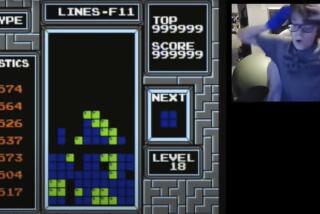Soviet Game Conquers the Free Market : Technology: Tetris, an electronic Rubik’s Cube, proves to be addictive. Sales are sizzling. Sequel is coming from East Bloc.
NEW YORK — Video game junkies now have an alternative to the zapping, blasting and pulverizing of the shoot-’em-up adventures popular on the fantasy screen.
Tetris, an addictive brain-twisting game, has no combat, no karate chops, no chases and no characters, not even a story line like the Super Mario Brothers.
This video cerebral challenge features building blocks--Soviet blocks, that is. Created by a Soviet scientist, Tetris is the first Eastern Bloc video game to hit it big in the free market.
“It’s a moving puzzle,” said Richard Epstein, 43, of Parsippany, N.J. “When I can’t sleep, instead of reading a book, I play Tetris.”
“I like the action games, but this is the first real strategy game,” said David Rodriguez, 16, of New York City. “You just can’t stop.”
Since its introduction to the world two years ago, Tetris sales have sizzled.
About 4 million copies are in use in homes, offices and arcades, mostly in the United States and Japan. The U.S. Software Publishers Assn. gave it four awards last year, including best original game and best entertainment program.
Its creator is chain-smoking Alexey Pazhitnov, 35, a researcher at the Academy of Sciences in Moscow who developed it in his spare time on his home computer, which is as rare as well-stocked food shelves in his homeland.
“When people started to play, they couldn’t stop,” Pazhitnov told an interviewer on a tour of the United States earlier this year. “The game was like a fire.”
Tetris is somewhat of an electronic Rubik’s Cube, and its creator prefers wizardry to war.
“I don’t like the violent games. I hate shooting games,” Pazhitnov said. “My idea is to make constructive games, not one where you destroy things.”
Tetris features seven geometric figures--rods, squares, zigzags, L-shapes and a squat T--each made up of four blocks. The name is derived from the Greek word “tetra,” which means four.
A shape selected at random falls on the screen, and the player can turn it on its side, steer where it goes and control how fast it falls. The object is to arrange the falling blocks in solid rows across the width of the screen, something that appeals to obsessive-compulsives and problem-solvers.
Filling in all the blanks does two things: It scores points and also makes the line disappear to allow room for more shapes.
If the blanks aren’t filled in, the blocks pile up like bricks in a wall. The game goes on until the screen fills up, which can take minutes or hours, depending on skill levels.
The game was adapted to personal computer software by a comrade, a teen-age khaker --Russian for hacker. It spread to Eastern Europe and then to England, where an enterprising London capitalist scooped up the rights and peddled it to Spectrum HoloByte of Alameda, Calif., which marketed the game for personal computers.
Since 1988, Spectrum has sold 150,000 copies at $39.95 each.
But the real action came last fall when Tetris became available on the Nintendo Entertainment System, which controls 80% of the U.S. home video market and has been the hottest-selling Christmas toy three years in a row.
About 1.5 million Nintendo Tetris games at $34.95 each were sold in the last six months, the company said.
Nintendo also put the puzzle on its Game Boy, an $89 hand-held unit about the size of a paperback book. Two million copies of Tetris now belong to Game Boy owners.
Another video power, Sega, adapted Tetris for video arcades.
But compulsion hasn’t meant riches for Pazhitnov. The game is marketed through ELORG, the Soviet Foreign Trade Assn., and all profits go to the Academy of Sciences.
Pazhitnov already has made a sequel called Welltris, a three-dimensional version honored this year by the Software Publishers, and has other games due out soon.
After years of plotting to export ideology and weaponry, the Soviets have found a smash with technology. But if the United States can send Bon Jovi, McDonald’s and Estee Lauder to Moscow, why not a Soviet video game enthralling American kids?
Although American parents and educators cringe at the time kids spend playing video games, one teacher believes Tetris can blast classroom boredom while it fosters spatial learning--the stuff of which IQ tests are made.
And it comes without the violence found in games such as Blaster Master or Mega Man 2.
“There’s a whole lot of high-order thinking going on. In its own way, it reveals a bit of the beauty of geometry,” said David Thornburg, director of the Thornburg Center for Professional Development in Mountain View, Calif.
“These video games have got these kids thinking. They’re not killing time,” Thornburg said. “We could do a whole lot to benefit our students if we could find out what makes them play video games and capture that enthusiasm for history, mathematics and language arts.”
Tetris junkies rarely think about geometric equations and classroom motivation when consumed by a game, however.
They’re too preoccupied with the shapes dribbling down their screens.
“I’ve seen those shapes in my sleep,” said Cindy Quinn, 29, who uses a computer in her job with a New York credit card company.
“I’ve played it in the morning a couple of times and it made me late for work. You can’t stop playing,” she said. “It’s such a disorderly world. There’s something about making things fit.”
More to Read
The biggest entertainment stories
Get our big stories about Hollywood, film, television, music, arts, culture and more right in your inbox as soon as they publish.
You may occasionally receive promotional content from the Los Angeles Times.










